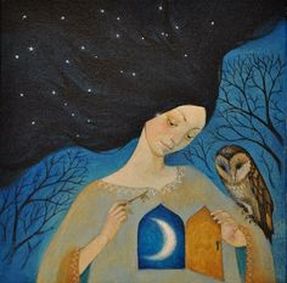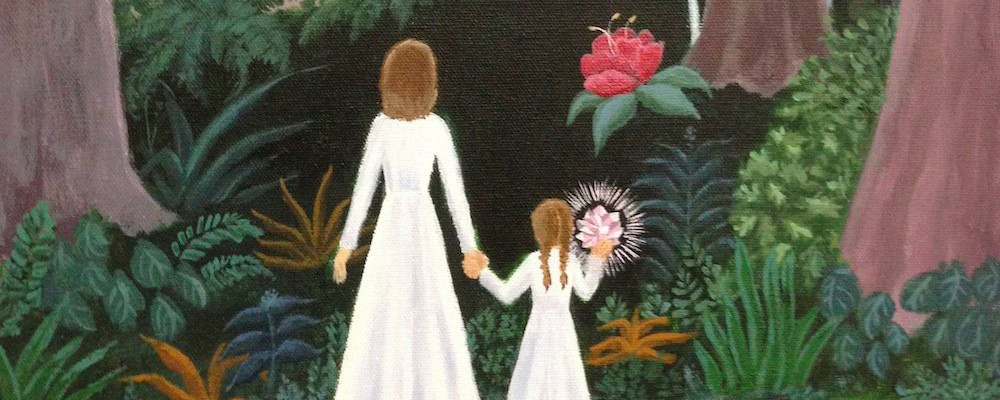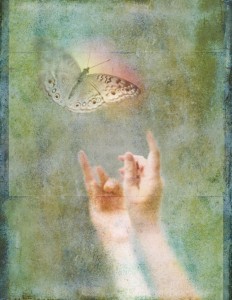'Only after the great awakening will we realize that this is the great dream.' Chuang Chou
The promise is that hitherto unconscious content – discovered here – can – once brought to awareness - be re-framed, re-configured so to speak, so that our subsequent experience of the ordinary, everyday past, present and future is changed.
I was somewhere and something happened.
It is a real place, he asserts - with it's own unique ontology and symbolic language that he calls the embodied imagination, a place not only frequented in dreams – as indicated - yet Bosnak suggests that the dream is infact the purest form of embodied imagination – and that by working with images derived from this domain – one might effect changes not only in one's emotional and spiritual life but changes that can filter through to one's actual bodily manifestation. Bosnak himself tells of his own massive reduction of symptoms from a chronic illness after beginning to work with images derived from his dreams.
The Dream Temples of Asclepius

The Asclepian Temple was open to all and Asclepius himself was said to dwell amongst the people and not on Olympus as you might expect. His story is one of rebellion against Zeus himself whom he infuriated by bringing certain popular heros back from the dead. Only the gods were immortal and as a terrible punishment for the violation of this key boundary, Zeus struck Asclepius with his thunderbolts and sent him to Hades – the first and only God in Greek mythology to experience such a death. His time in the underworld was brief – as was fitting for a god - yet as a result Asclepius came to understand the mortal condition like no other before him and therafter became known as The Wounded Healer, beloved of all the people.
Now those who made their way to the Temple of Asclepius at Euripedes were often those whom local physicians had failed to assist. The process began with three days of ritual fasting and prayers, often offered to Memory, mother of the muses, for the source of all disease was held to be of a spiritual nature - a seperation from God - a dis-membering or forgetfulness that needed to be made good, needed to be re-membered in order for health to return.
After these preparations the person would be led to an enclosed chamber containing only the flat stone clince mentioned above. The hope was that Asclepius himself would visit them in their dreams, elucidating the underlying causes of their malaise and offerring ways forward back to health – but always – and this feels so significant and worthy of mention – that any healing – physical or otherwise that followed as a result of these ' visitations' was not intended to prolong life indefinitely - but merely to provide additional time for the afflicted to deepen their spiritual practice.
When subjects awoke – they were encouraged to share their dreams with the priest or priestess of the temple – who were called the therapuetes - meaning those who attended the gods - and this telling – simple as it may seem - together with being empathically heard - was then and has remained at the very core of the psychotherapeutic modality.
So crucial are these two components that, as was pointed out to me recently - it only takes one empathic adult to really hear a child’s hints of abuse - & for that adult to let the child know that what is happening to them is wrong – for the entire course of that child’s future to be radically changed. There ia a quality to this listening which lies at the heart of good therapy - a way of becoming deeply immersed into the field of the other - so that every subtlety and nuance is attended to. When done well - as I have witnessed as an observer several times - it can be quite breath-taking.
In the Quest for the Holy Grail for example - Sir Bors returns to Camelot with stories of the great quest. In the Lord of the Rings we see first Bilbo Bagins then Frodo - setting down the tales of their adventures in the chronicle - There and Back Again.
Ancient traditions all - reflecting the universal patterns of the healing process that flourished for thousands of years - before the great split in the development of Western thought - before the ideas of Aristotle sur-planted those of neo-Platonism & the church later secured its dominion over all revelatory experience. From then on in all otherworldy experience was mediated by the priesthood, with anything falling outside being very likely deemed heretical.

Dreams were not again thought to have any relevance to our well being until Freud and Jung re-established their importance in the early 20th century. It was Freud - who reminded us of the need to make the unconscious conscious and Jung who enlarged this thinking to include the vastness of the collective. Both men were profoundly spiritual and it is worth remembering that when they wrote of psyche and the unconscious and developed their analytical methods - it was for the expressed purpose of exploring the soul. Psyche is of course the Greek word for soul - yet its meaning was tragically lost when their works crossed the Atlantic and were translated into English. Understood as meant however - the language and methods of both Freud and Jung were consistent with those of the therapuetes of ancient greece - for they too created portals to the imaginal, by way of their active imagination and free association - methods designed to bypass the conscious mind and facilitate insight. Even the treatment couches in the consulting rooms where they listened to their clients dreams were not disimilar to the Asclepian clince.
Who or what was now encountered in the imaginal may no longer have been understood in terms of direct communion with 'the gods' - our collective terminology and perceived personal relationship to the numinous had undergone radical transformation since ancient times and yet if we are to believe Jung and his writings in The Red Book, completed after his famous split from Freud, in which he decscribes his indepth exploration of his own imaginal world - we may be left wondering about the nature of the archetypal energies he encountered - and forgiven for noticing - that his idea of the 'objective psyche' was not qualitatively dissimilar to its once divine ancient counterpart.
There is a quintessential moment in the deveopment of Jungian psychology, Michael Conforti tells us - a turning point if you like, when Jung himself was forced to ackowledge the objective reality of the imaginal realm. It occurred during one of his fanciful conversations with characters from the old testament during which Elijah suddenly appears to speak back to him quite autonomously.
But you are just a figment of my imagination,
counters Jung - so how come you are speaking back to me?'
Elijah replies -
Don't ever speak to me like that again!
We are more than real than anything in the outer world!
If this is true, the great master thought to himself, then this changes everything - and it did - bringing us if you like full circle - back to the Healing Temples of Asclepius and the possibilities of direct revelatory experience with a pre-figured, objective archetypal field.
Many of the post- jungians have moved away from these fundemental ideas - and other psychological theories that later came to prominance in the 20th century certainly rejected these notions - partially if not completely - yet they remain charcteristic of the Zurich School and its founding members and those who have continued in their footsteps.
"Who or what looks at us more clearly and relentlessly than one's best friend or enemy could ever do. It must be a being of the most superior intelligence judging from the depth and cleverness of the dream.
Marie Louise Von Franz
In the ancient world - as we have seen - this superior intelligence was understood as 'the gods'. Today it is generally regarded simply as a metaphore for the part of the self that knows - the transcendent or transpersonal function - but no matter whether these powerful archetypes are within or without - whether they be make- believe or not - they are sacred never-the-less - and in their numinoius presense we may rightly bow and bend our knees in awe.
Fairy-stories, myths & legends as portals to the imaginal
Fairy- stories, myths and legends are our collective dreams if you like - that speak to us of these archetypally pre-figured, imaginal fields.
By way of resonance we are drawn toward those stories that will serve us most. Certain tales call to us at different times, sometimes the themes are personal, sometimes collective or even both. Stories like The Quest for the Grail and The Sleeping Beauty for example, can point in different ways to what has been dis-regarded within the self and also in the collective and to what needs to be done - and how, in order to bring about a more healthy equilibrium. Beauty itself becomes the archetype here - expressed as both the sleeping princess and the dis-honoured Grail Maiden - calling to us from behind the Hedge of Thorn - from the Wastelands - beckoning us to inquire as to what is really amiss - to what might lie beyond or within - and who will come at last to ask the the sacred question that will take the story on?
Children are born understanding the difference between the imaginal and the everyday - they know what belongs in Once upon a time and what not - they know where animals can talk - where princes can be turned into swans, frogs into princes, where children can fly - or can't as the case may be - and they believe utterly - until we dis-enchant them - in the absolute reality of both worlds - and unless it is really knocked out of them - in the achievability, by virtue of what is gleaned - of the possibilty of resolution - of always being able to find their way home - no matter what.
It a mistake however to believe the tales are just for children. Nothing could be further from the truth. Like our dreams and imaginings, they too have become diminished in importance within the collective - with its continuing over emphasis upon rationalty. They have been relegated to the nursery long ago - dismissed as simply make - believe.
What is real in the everyday sense is what counts - more and more as children grow and outgrow the genre - yet advances in physics clearly show that what we apprended as real - as solid- is not really so solid at all - and that matter is profoundly influenced by our consciousness.
Reality, wrote Pierre Teilhard de Chardin is neither wholly of the psyche nor wholly material but rather an exquisite interplay - a dance if you like - between what quantum phyisists have termed wave and particle - waves being of psyche and particles of matter - and always it seems - just as the early Asclepian healers and their 20th century counterparts suspected - though the science was not then able to support their contentions - consciousness preceeds form.
'Matter is spirit moving slow enough to be seen'
Pierre Teilhard de Chardin
When I began to write this article I was fairly clear where I wanted to go - what I wanted to explore - then the process began and I found myself taking a very different path, several paths actually and I was unsure where each would lead. Would they join up with the main idea or would I get completly lost and confused. I must confess to feeling overwhelmed by the vastness of the theme at times, almost to the point of tears - then quite by chance I was suddenly able to relax, let go and somehow start watching the threads coming together beneath my fingers. How? By asking not so much what I wanted to say - but rather - what wanted to be said. And in asking I took a back seat so to speak and listened - and here we are - already approaching the conclusion - not at all meant to be definitive of course - the themes are far too vast for anything like that - just some closing reflections upon the questions posed.

We may no longer have dream temples – yet we can speak of such realms with our children – a practice still common amongst certain indigenous peoples where the sharing of dreams is an important part of each day. Those who are troubled by disturbing dreams may request advice - and are sometimes encouraged to interact with the symbols - turning to face the monster – asking what it might want – what it represents – these things can be hugely transformative.
And thankfully – we still have story – we still have Once upon a time ....
So when you next have the opportunity to tell a bedtime story to a small child, as I have had recently - or when indeed by great good fortune you happen to be told one yourself – bare in mind that the opening phrase Once upon a time is in fact an ancient incantation – a potent spell brought down through time designed to literally - bring you within the song – the deep, deep song of our shared imaginal world – and there – if we believe it to be so – we can explore ways in which we may all find our own way through what Tolkien calls the perilous realms – toward the longed for and universally pre- figured field of Happily Ever After.
much love
Anne Maria Clarke
x x x
Michael Conforti - Dreams, Jung, M.L. Von Franz
Robert Bosnak - The Phenomenal Power of Asclepian Dream Incubation.
Christine Downing - Only the Wounded Healer Heals
Coming soon: Tolkien – on Fairy-Stories
Subscribe to Anne Maria Clarke's YouTube channel
http://www.youtube.com/c/annemariaclarke
More fairy-stories & adaptations of myths & legends by Anne Maria Clarke
http://www.archivepublishing
www.annemariaclarke.net





